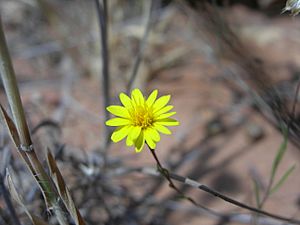Golden-rayed pentachaeta facts for kids
Quick facts for kids Golden-rayed pentachaeta |
|
|---|---|
 |
|
| ssp. aurea | |
| Conservation status | |
| Scientific classification | |
| Kingdom: | |
| (unranked): | |
| (unranked): | |
| (unranked): | |
| Order: | |
| Family: | |
| Genus: | |
| Species: |
P. aurea
|
| Binomial name | |
| Pentachaeta aurea Nutt.
|
|
| Synonyms | |
|
Chaetopappa aurea |
|
Pentachaeta aurea is a type of flowering plant. It belongs to the aster family, which includes many well-known flowers like sunflowers and daisies. People often call it the golden-rayed pentachaeta, golden chaetopappa, or golden leastdaisy. These names come from its bright, golden-yellow flowers.
Where Does It Grow?
This plant is native to sunny southern California. You can find it growing in mountain areas like the San Gabriel Mountains and San Bernardino Mountains. It also lives in the Peninsular Ranges. You might even spot it in northern Baja California, which is just south of the border. It likes to grow in places with chaparral and woodlands.
What Does It Look Like?
The golden-rayed pentachaeta is an annual herb. This means it grows from a seed, flowers, produces new seeds, and then dies all within one year.
Its Stem and Leaves
- It has a stem that can grow up to about 36 centimeters tall. That's about the length of a standard ruler!
- The stem is often covered in small hairs, making it feel a bit fuzzy.
- Its leaves are long and narrow, like thin blades. They can be up to 5 centimeters long.
- The leaves are only a few millimeters wide. They might also be quite hairy.
Its Flowers
- Each plant can have many flower heads, sometimes up to 22!
- Each flower head is like a tiny daisy. It has two main parts:
- Ray florets: These are the "petals" you see around the outside. They are usually yellow, but can sometimes be brownish or whitish. They are about 3 to 12 millimeters long.
- Disc florets: These are the tiny flowers packed tightly in the center. They are usually yellow or reddish and have five small lobes.
Its Fruit
After the flowers bloom, the plant produces small fruits. These fruits are called achenes. Each achene has a special feathery top called a pappus. This pappus helps the seeds float away in the wind, spreading the plant to new places.


